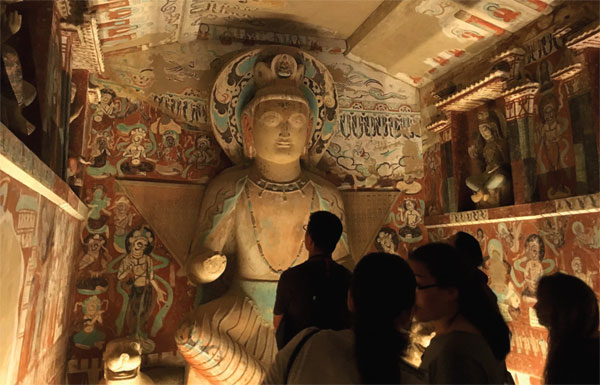Ancient Dunhuang inspires cultural exchanges

Visitors experience one of the three full-size replica caves, part of the ongoing exhibition Cave Temples of Dunhuang, which runs through Sept 4 at the Getty Center in Los Angeles. The replica caves, created by artists from the Dunhuang Academy's Fine Arts Institute, were constructed through a painstaking, multiyear process. [Photo/China Daily]
Dunhuang, an ancient Chinese city on the Silk Road that witnessed great cultures and ideas for more than a millennium, continues to inspire.
An exhibition at the Getty Center in Los Angeles, Cave Temples of Dunhuang: Buddhist Art on China's Silk Road, presents more than 40 original objects from what is known as "Library Cave" and three hand-painted replica caves.
"Dunhuang is in California," said Susan Pertel Jain, executive director of the Confucius Institute at UCLA. She led an educational tour for 17 middle school and high school teachers.
More than 1,000 years ago, in the tiny oasis town in Northwest China, hundreds of cave temples were carved into a giant cliff face and decorated with Buddhist murals and sculptures, known as Mogao Grottoes.
The extensive cave temple complex, a UNESCO World Heritage site, thrived as a center of international trade, cultural exchange, religion and art from the fourth to the 14th centuries.
Jain found something in common between the modern-day Los Angeles and the ancient Chinese town.
"We are a trade center, we are an art center, we are an immigrant center, and our ideas are continuing to shape," Jain said.
The theme of the program is teaching about China as a crossroads linking then and now, East and West. At the end of the program, the teachers will create a lesson about Dunhuang, integrating the culture into art, math, social studies and other subjects, to make connections to the children in California.
Dunhuang not only reflects the creative, intellectual and spiritual environment of early medieval China but also the considerable cultural impact of the transmission of Buddhism along the Silk Road, according to Marcia Reed, chief curator at the Getty Research Institute.
One of the exhibition's galleries focuses on the diversity of languages and religions on the Silk Road, including a Buddhist sutra in Tibetan with commentary in Chinese, a Jewish prayer in Hebrew, and a Christian manuscript in Chinese, all written no later than the 10th century.
A highlight of the exhibition is the Diamond Sutra that dates to the year 868 CE. On loan to the Getty from the British Library, the Diamond Sutra is believed to be the world's oldest dated, complete printed book.
"The scroll is a printed complete book and the woodblock technology was applied long, long before the Guttenberg metal type," said Reed. Guttenberg printed a book around 1457, and "that's a long time before movable metal type for printed books in Europe," Reed said.
"Hidden and coming out in the beginning of the 20th century, it is an amazing story, and a mystery story because we don't know who put the materials in the caves and when exactly it was done," she said. "In a way it also is a to-be-continued story as we learn more. That's fascinating."
The exhibition is also a result of 25 years of collaborative efforts between the Getty Conservation Institute and the Dunhuang Academy on the conservation and management of the site.
The site in China has been widely visited, but it is the first time the Getty has built three full-size replica caves to provide visitors with a deeper understanding of the Mogao site and the scale of the cave temples there.
Reed said it was crucial to design the exhibition in a way to show "respectfulness" for Dunhuang history, Buddhist practice and the artists in colors, wording and the proper spacings.
"I enjoy the calmness and the serenity of the Buddhas - the beautiful ceilings and spiritual Buddha's style and art work are very illuminating," said Rochelle, a visitor at the replica caves.
"It's also very touching to see that they've lasted all these years," she said.
Rochelle said she had never been to Dunhuang herself, but her mother-in-law had been there three times and brought back beautiful pieces of art and antiques.
"I love spiritual research on Buddha, and other parts of art and spirituality. I find this amazing," said Rochelle, who took more than 20 pictures of the caves.
"This is a very positive development because cultural exchange is often a good way for people to communicate and gives us perhaps a bit more stability in how we deal with each other," said Ted Lipman, CEO of The Robert H. N. Ho Family Foundation, which sponsored the Dunhuang exhibition.
Your Comment
Name E-mailRelated News
-
;
-
-
Exhibition "Cave Temples of Dunhuang" opens to public in U.S.
LOSANGELES,May7,2016(Xinhua)--PhototakenonMay6,2016showsthe"CaveTemplesofDunhuang:BuddhistArtonChina'sSilkRoad"exhibitionatGettyCenterinLosAngeles,theUnitedStates.
-
-
-
Drained Dunhuang Tibetan literature to be published
About 10,000 Tibetan documents drained overseas from the Mogao Grottoes, Dunhuang, Gansu Province, are being published in China in the form of books, according to Northwest University for Nationalities.
-
-
-
Tibetan religious books uncovered in Dunhuang
The Dunhuang Archives Bureau recently discovered among its collections a number of religious books written in Tibetan language.
-
Based in Lhasa, Tibet Vista is a Tibet travel agency that specialized in Tibet permit, and Tibet tours for both private and group travelers at a local price!
•4 Days Lhasa City Group Tour from USD 460 •8 Days Everest Base Camp Group Tour from USD 850 •15 Days Mt.Kailash Group Tour from USD 1780 •2016 Tibet Train Tours from Beijing, Shanghai, Chengdu, Xining,etc










